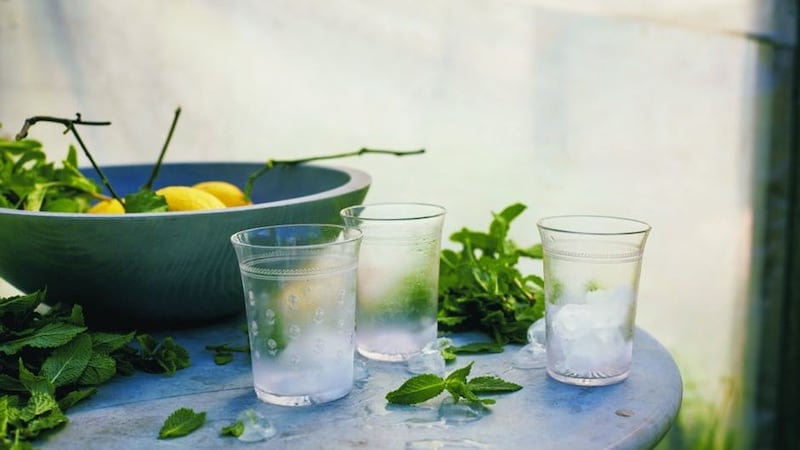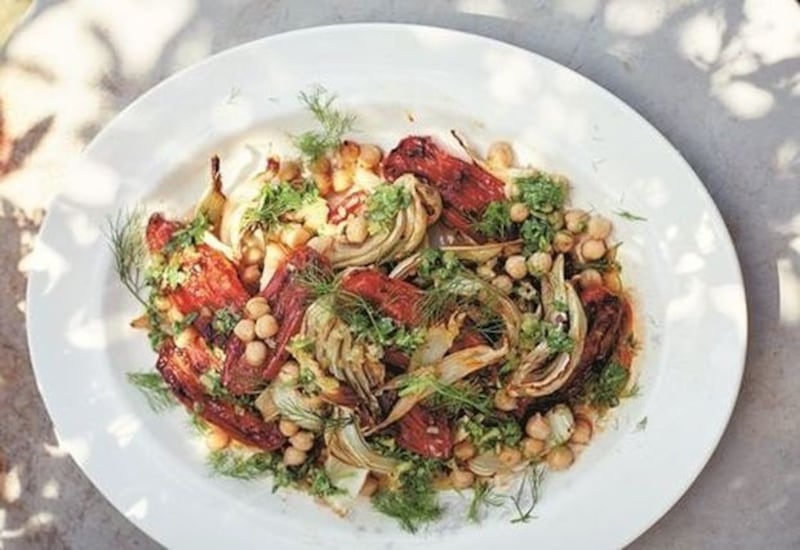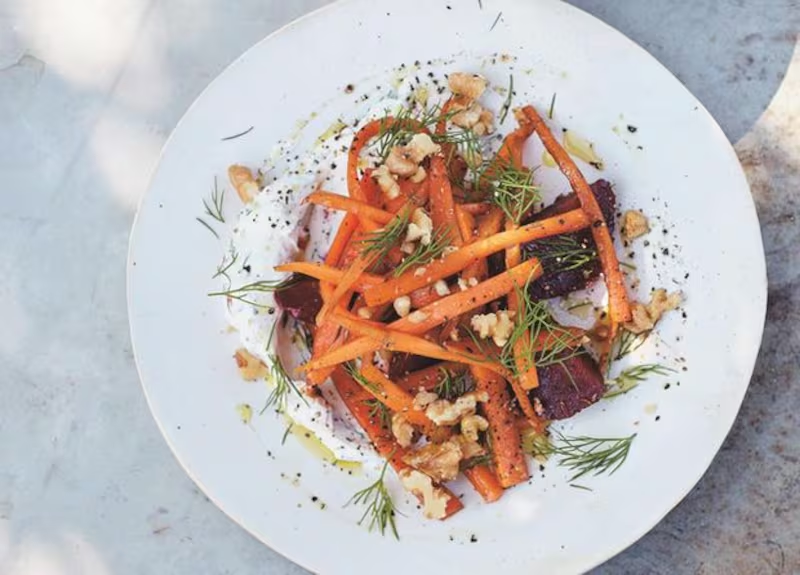Today it’s 28 degrees outside and I’m writing in the cool of my study. In fact, I’m hiding as well as writing. Not loving hot weather makes me unpopular. Most of my friends are sun lizards. Me, I feel defeated, bothered, out of sorts. I moan and refuse to go for a walk on the nearby heath until the sun’s down.
My only explanation is that I’m Irish. I’m used to cool and wet summers – I like a ‘soft day’, I prefer the temperature to be gentle rather than see the banner headline ‘Scorchio!’, I even like pewter skies.
Really hot weather also stops me doing something I love, which is cooking.

The autumn and winter appetite is a sure one. We need food to keep warm, and we love to hunker down in the kitchen. I am comforted when I tie my apron at the back or feel the soft weight of a bag of flour as I take it from the shelf. But in the summer, you don’t know whether you want to eat, never mind cook. Our heads are filled with fantasies of hot-weather cooking, though, snatched from cookbooks with pictures of shady French terraces and stone-cool Italian kitchens.
I have served a Provençal grand aioli of poached salt cod, hard-boiled eggs and vegetables on a day so hot the garlic mayonnaise developed an off-putting layer of oil on top. Guests mopped the perspiration from their brows while trying to look happy. I wanted to retreat indoors but felt I had to carry the event through to the end.
Sweating meat
What hot weather requires is food you can cook in advance, that behaves well, that can stay in the fridge then come to room temperature quickly. You don’t want to worry about sweating meat or turning cream. I know salad seems the most appropriate dish, but I don’t even want to toss leaves. In the heat, I prepare food for friends the night before. After 10pm, the evening is cool enough to bear the heat of the oven.
For this menu, the fennel and tomatoes just have to be roasted then combined the next day with the dressing. Make couscous, to have on the side, ahead of time and serve it at room temperature too (but don’t add any herbs until the last minute).
The starter – the carrots and beetroot – just need to be cut (you can sauté them with the cumin seeds the night before or on the morning of the day you want to serve them) and the yoghurt for the haydari just has to drain in the fridge.
If the shortbread seems an effort too far (and too hot) buy some instead. Should a really hot day be forecast, you can dispense with the pudding altogether and serve fresh cherries piled on top of ice (you'll find bags of ice in an off licence). I once had this in Greece, served with wedges of melon. Ice-cold cherries and melon was exactly what I wanted.
With the sun blazing, do you feel like standing over a barbecue, or boiling potatoes to go with poached salmon that you worry has already suffered in the heat? Me neither. Let’s just pull some good dishes from the fridge, pour the rosé and chill.
How to Eat a Peach: menus, stories and places by Diana Henry is published by Mitchell Beazley, £25 (www.octopusbooks.co.uk)
Roast tomatoes, fennel & chickpeas with preserved lemons & honey

It might seem a hassle to roast the fennel and tomatoes separately, but it does make things easier when you come to assemble this, as each element stays intact and keeps its shape. You can use flat-leaf parsley or mint leaves instead of coriander in the dressing, or extend the dish by adding salad leaves (rocket, watercress or baby spinach) if you like, though then you’ll need to make a bit more dressing. You can make all the elements ahead of time. Serve with saffron couscous, it’s a great contrast in both colour and texture.
Ingredients
Serves 6
For the tomatoes
- 10 large plum tomatoes
- 3 tablespoons regular olive oil
- 1 tablespoon balsamic vinegar
- 1½ tablespoons harissa
- 2 teaspoons caster sugar
- Sea salt flakes and freshly ground black pepper
For the fennel
- 2 large fennel bulbs
- Juice of ½ lemon
- 2 garlic cloves, crushed
- ½ teaspoon fennel seeds, coarsely crushed in a mortar
- Generous pinch of chilli flakes
- 2½ tablespoons extra virgin olive oil
- 400g can of chickpeas, drained and rinsed
For the dressing
- 2 small preserved lemons, plus 2 teaspoons juice from the jar
- 2 tablespoons white wine vinegar
- 1½ tablespoons runny honey
- 5 tablespoons extra virgin olive oil
- 4 tablespoons chopped coriander
Method
Preheat the oven to 190°C/375°F/gas mark 5.
Halve the tomatoes lengthways and lay in a single layer in a roasting tin or ovenproof dish. Mix the regular olive oil, balsamic vinegar and harissa and pour this over the tomatoes, tossing to coat well, then turn the tomatoes cut sides up. Sprinkle with the sugar and season. Quarter the fennel bulbs, cut off the stalks and remove any coarse outer leaves. Pull off any tender fronds (reserve these) and cut each piece of fennel into 2.5cm- (1in-) thick wedges, keeping them intact at the base. Toss in a bowl with the lemon juice (it stops them discolouring). Add the garlic, fennel seeds, chilli and extra virgin olive oil, then season and turn everything over with your hands. Spread out the fennel in a second roasting tin and cover tightly with foil.
Put both trays in the oven. Roast the fennel for 25–30 minutes, until tender (the undersides should be pale gold), then remove the foil and roast for another 5–10 minutes, or until soft, golden and slightly charred. Roast the tomatoes for 35–40 minutes, or until caramelized in patches and slightly shrunken. Stir the chickpeas into the fennel and taste for seasoning. Leave both to cool to room temperature.
Now make the dressing. Discard the flesh from the preserved lemons and cut the rind into dice. Whisk the wine vinegar with the preserved lemon juice, honey and extra virgin olive oil, season and add the lemon rind and coriander. Taste for seasoning and sweet-sour balance.
Arrange the fennel, chickpeas and tomatoes on a platter, adding all the juices from the roasting tins; there might be quite a bit from the tomatoes. Scatter any fennel fronds you reserved over the top. Spoon on the dressing, or serve it on the side.
Beetroots & carrots with cumin & haydari

Haydari is a mixture of strained yogurt, herbs and garlic. I like chilli in it, too, as that way you get some heat against the coolness of yogurt. It’s a bit of a pain to cut the carrots into matchsticks, but it’s the only taxing thing about this recipe. You can roast the beetroots yourself, but you’re not supposed to be doing much cooking here, so buying ready-cooked stuff – as long as it’s not pickled – is fine.
Ingredients
Serves 6
- 400g (14oz) Greek yogurt
- Extra virgin olive oil
- 15g (½oz) bunch of dill, leaves only, roughly chopped
- 2 garlic cloves, crushed
- 1 red and 1 green chilli, halved, deseeded and very finely chopped
- Sea salt flakes and freshly ground black pepper
- 800g (1lb 12oz) carrots
- 600g (1lb 5oz) cooked beetroots
- 2 teaspoons cumin seeds
- ½ tablespoon white balsamic vinegar
- ½ lemon
- 25g (1oz) walnut pieces, lightly toasted
Method
Start this dish 2 hours ahead of when you want to serve it. Line a sieve with a piece of muslin or a brand new J-cloth and set over a bowl. Tip the yogurt into this and leave for a couple of hours. It doesn't need to get that much thicker.
Put the strained yogurt into a bowl and add 2 tablespoons of extra virgin olive oil, most of the chopped dill, the garlic, chillies and seasoning. Don’t overmix; you should be able to see flecks of chilli.
Peel and cut the carrots into matchsticks. They don’t have to be very neat. Cut the beetroots into slim wedges.
Heat 2 tablespoons extra virgin oil in a large frying pan over a medium heat. Add half the cumin seeds and allow them to cook for about 30 seconds, then add the carrots. Stir-fry the carrots for about 1 minute: they need to lose their rawness, but still retain crispness so that they contrast with the soft beetroot. Add the white balsamic vinegar, a generous squeeze of lemon juice and seasoning.
Quickly transfer to a bowl. Add another tablespoon of extra virgin olive oil to the pan with the rest of the cumin seeds. Cook for 30 seconds, then add the beetroots. All you want to do is get them flavoured with the cumin and heated through a little, they don’t have to be hot. Squeeze on some lemon juice and season.
Put some of the haydari on each of 6 plates, flattening it and swirling it with the back of a spoon. Spoon some beetroots on top, then some carrots. Sprinkle with the remaining dill and the walnuts, splash with a little more extra virgin olive oil and serve.
Cherries in wine with cardamom cream & rose pistachio shortbrea
Make this the day before and serve it chilled. The cherries can be pitted or unpitted: unpitted looks better (and is less hassle for the cook); pitted is easier for eaters, though if you pit the cherries as you eat them you can play 'Tinker, Tailor, Soldier, Sailor' at the table.
Ingredients
Serves 6
For the cherries
- 250g (9oz) granulated sugar
- 600ml (1 pint) Valpolicella, Pinot Noir, or other cherryish red wine
- 2 broad strips of lemon zest
- 900g (2lb) cherries
- 3 tablespoons kirsch (optional)
- Squeeze of lemon juice (optional)
For the shortbread
- 185g (6¼oz) unsalted butter, slightly softened
- 75g (2¾oz) icing sugar, plus more to serve, plus more for the cream
- Pinch of sea salt flakes
- Finely grated zest of 1 unwaxed lemon
- 175g (6oz) plain flour, plus more to dust
- 75g (2¾oz) cornflour
- 1 teaspoon rose water
- 1 egg, lightly beaten
- 50g (1¾oz) shelled unsalted
- Pistachio nuts, chopped
- Candied rose petals (optional)
For the cream
- Seeds from 4 green cardamom pods
- 300ml (½ pint) whipping cream
Method
Put the sugar for the cherries into a large saucepan with the wine, 200ml (7fl oz) of water and the strips of lemon zest. Bring to the boil, stirring to help the sugar dissolve, then boil for 8 minutes.
Reduce the heat, add the cherries and simmer for 4 minutes. Lift the cherries out with a slotted spoon on to a tray or rimmed baking sheet; they will stop cooking if they’re not touching each other.
Leave the syrup to cool, then taste and add a slug of kirsch if you want to, or a good squeeze of lemon juice; sometimes the syrup needs this to cut the sugar a bit, it depends how sweet your cherries are.
Put the cherries in a bowl and pour over the red wine syrup.
To make the biscuits, beat the butter and icing sugar until creamy, then add the salt and zest. With the mixer on a low speed, add the flour, cornflour and rose water and beat them together. Take the dough out of the mixer and, on a lightly floured surface, shape it into a log about 6cm (2½in) in diameter. Brush with beaten egg, then roll it in pistachios. Carefully wrap in foil and chill for 1 hour or so.
Preheat the oven to 180°C/350°F/gas mark 4.
Cut the log into biscuits, 3–4mm (¹/6in) thick, and lay them, 2.5cm (1in) apart, on baking sheets. Bake for 15 minutes – they will just turn a little golden round the edges – then leave to cool for 10 minutes. Carefully lift them on to a wire rack with a palette knife: they are very fragile, so be careful. Before serving, sift a little icing sugar over the top and sprinkle on some candied rose petals, if you like.
Grind the cardamom seeds in a mortar, or in a heavy bowl with the end of a rolling pin. Put the cream in a bowl, add the cardamom, then whip the cream until it’s holding its shape, adding icing sugar to taste.
Serve the cherries with the shortbread and cardamom cream.














